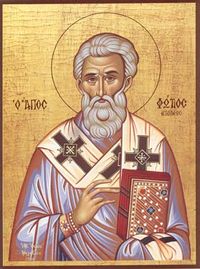
Feastday: June 10
Death: 661
St. Landericus (or Landry) was a sincere and dedicated servant of God who, like his Lord Jesus Christ, had great love for the poor and the lowly. As Bishop of Paris, from 650-661, he labored zealously to improve their lot. And when the proceeds from the sale of all his possessions did not suffice to relieve their hungry during a famine, he went so far as to sell some of the Church vessels and furniture. St. Landericus became increasingly aware that the sick poor of his diocese were not really cared for by the custom then in vogue of housing them in little hostels dependent on the casual alms of charitable persons. This led him to erect the city's first real hospital, dedicated to St. Christopher, which in time became the famous Hotel-Dieu. Always on the alert to provide spiritual help for his people, this saintly bishop welcomed the Benedictines into his diocese and encouraged them to set up the Abbey of Denis. In 653, in company with twenty-three other bishops, he signed the foundation charter granted by King Clovis to the Abbey. He died about 661 after having commissioned the monk Marculfus to compile a collection of Ecclesiastical Formulas. His feast day is June 10.
Free Catholic Printable Learning PDFs
All Free PDF's Most Popular New Releases Lent / Easter Stations of the Cross Saints Prayers Rosary Mary Sacraments Apostolic Exhortation Books Coloring Books Encyclicals Español Jesus Novenas Saints Fun FactsSaint Landry (Landericus) of Paris (died c. 661) was a bishop of Paris and is recognized as a saint by the Roman Catholic Church. Landry built a hospital dedicated to St. Christopher, which later became the Hôtel-Dieu de Paris. His feast day is 10 June.
Life
Landry was chief clerk of the Royal Chancery. In 650, he succeeded Audobertus as Bishop of Paris. During the famine of 650-51, Bishop Landry sold all of his personal possessions, as well as some of the furniture and sacred vessels of the church, to feed the poor.
He is credited with building the first major hospital in the city, dedicating it to Saint Christopher, (now the Hôtel-Dieu).
In 653, Landry, with 23 other bishops, subscribed to the charter Clovis II gave to Saint-Denis Abbey, exempting it from episcopal jurisdiction. It is believed that he built the original church of Saint-Germain l'Auxerrois, which became the parish church of the kings of France.
He died in 661.
Veneration
 Eglise Saint-Landry, c.1810
Eglise Saint-Landry, c.1810
He was buried at the Church of Saint-Germain-l'Auxerrois, where there is a chapel named after him and most of his relics are kept, except for two bones that were given to the parish of Saint-Landry in 1408, which was originally a chapel near the saint’s house in which he was accustomed to pray. He is honored with an office in the new Paris Breviary.
His feast day is 10 June.
Miracles were recorded of him. One of them reads:
We have seen and known that a man which men call Raoul Gracard was smitten suddenly, and had the head much great and swollen, and was so red in the face of him that all folk that saw him deemed and held him for a leper. Which man with great haste came to the presence of Saint Landry, and there he confessed him much devoutly, receiving much benignly his penance, and after he came to the sudary of the saint and with great devotion kissed it, and when he had done his offering and vow with much great faith and hope he returned, and unnethe [hardly] he was come to his house when he became as whole as ever he was.
— Jacob de Voragine, The Golden Legend,
St. Landry Catholic Church, in Opelousas, Louisiana is dedicated to Landry of Paris. A statue of Saint Landry stands behind the altar, and a stained glass window with his image at the southwest corner of the church. The civil parish of St. Landry, located in south Louisiana, is named after the church.
Port St-Landry was Paris' first dock.





